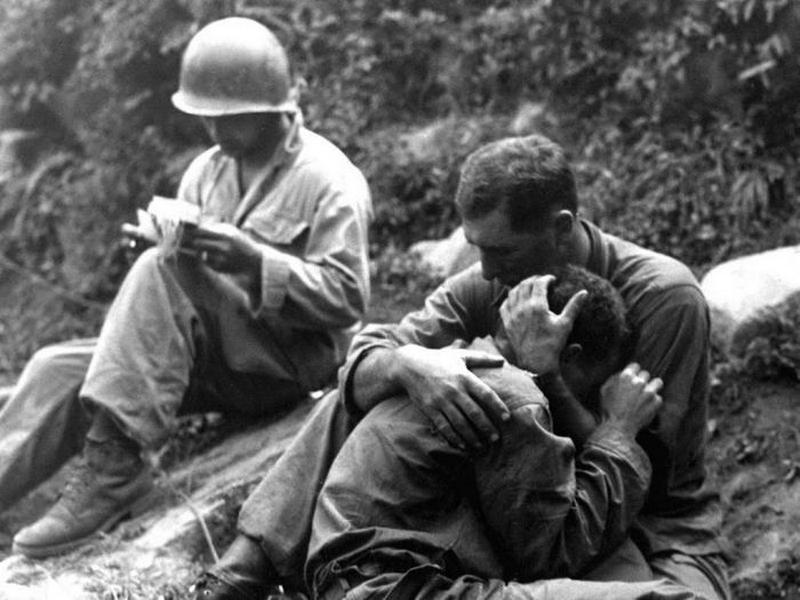Side Effects From The War: PTSD
By | December 3, 2018
Image: A grief stricken American infantryman is comforted by another soldier in the Haktong-ni area, Korea, August 28 1950. (U.S. ARMY KOREA HISTORICAL IMAGE ARCHIVE/ FLICKR)
What is PTSD? PTSD stands for Posttraumatic Stress Disorder which is a serious condition that develops after a person has experienced something very traumatic in their life, in this case, war.
In most cases, under normal conditions, a person can overcome feelings of anger, shock, fear, nervousness, and guilt after a tragic event in their life, but for those who suffer from PTSD, it’s not so easy. For them, the condition only worsens. Symptoms include: reliving the event or events through flashbacks, nightmares, and hallucinations; avoiding places or people that remind them of the trauma; increased emotional changes such as outbursts of anger, inability to feel or show emotion, trouble falling or staying asleep, irritability, difficulty concentrating, and other negative emotions.
Around 2.5 percent of the total population in the U.S., which is about eight million people suffer from PTSD and the rate goes even higher among veterans who were in Iraq and Afghanistan. A lot of these are undiagnosed and are at risk of losing family and careers. Some have even committed suicide because of the effect this condition has on them. It not only affects the individual who has it but also their family and friends.
Some Vietnam veterans had anxiety related to combat but were not diagnosed with PTSD because, at that time, there was no name given to the disorder. For that reason, they did not receive honorable discharges. A lot of them were discharged for “medical” or other reasons but no name was given as to their mental state. This caused some to lose their rank. As they tried to get back into society, they did not understand what was wrong with them and why they would simply walk away from good jobs for no reason. Since 1980, the military has become more familiar with the disorder but there are still some veterans struggling, not only with the disorder but also struggling to receive compensation from the government.
A veteran visits the Vietnam War Memorial in Washington, D.C. in 1988. (Owen Franken/Corbis)
If this debilitating condition is not taken serious enough by the “powers that be” what lies ahead for those in the military now or in the future? There are studies being done now to assess the effects over time of war-time veterans in hopes to help future veterans. These studies are even being done by historians going back to soldiers from the Civil War in America as well as ancient Assyria in 1300 B.C. The studies involve gathering information from those still alive through methods such as health questionnaires and telephone interviews. According to some of the research that is being done, more than one-third of veterans who suffer from war-zone PTSD also suffer from major depression.
shell-shock-history-timeline
It was once considered cowardice for men in the war who suffered from shell shock. They were even put on trial and executed for it. Shellshock was considered a lack of character. In post-war Royal Commission, Lord Gort said in his testimony that shell shock was a weakness and good units did not have that. Many shell-shocked soldiers from World War One had amnesia and couldn’t remember their own name. There was one in particular in the 1920s, “George Brown” who became famous as the “Unknown Patient of Callan Park (mental hospital in Sydney, Australia)” as there were hundreds of people showing up to see if he was their long-lost husband, brother, or son.
Scenes like this one are part of the reason for shell-shocked veterans and those suffering from PTSD. Many soldiers have had to shoot and kill innocent civilians who had nothing at all to do with the war. The guilt of that kind of killing is not an easy thing to get over. Other soldiers were side by side with fellow soldiers that they trained with and became comrades with who were killed or maimed right before their eyes. It is no wonder that they suffer from nightmares and hallucinations. Then there are soldiers who became prisoners of war and had to endure being held in an enemy camp with deplorable conditions. Some of these veterans have come back with a lot of physical disabilities such as paralysis, missing limbs, eyes, or other body parts that are visible signs of what they went through. But how much worse is it to survive being physically torn to being mentally handicapped and no one even recognizes it?
Hopefully, through new studies being done and an awareness of the problem, the pitfalls of the past can shed new light on the future.







